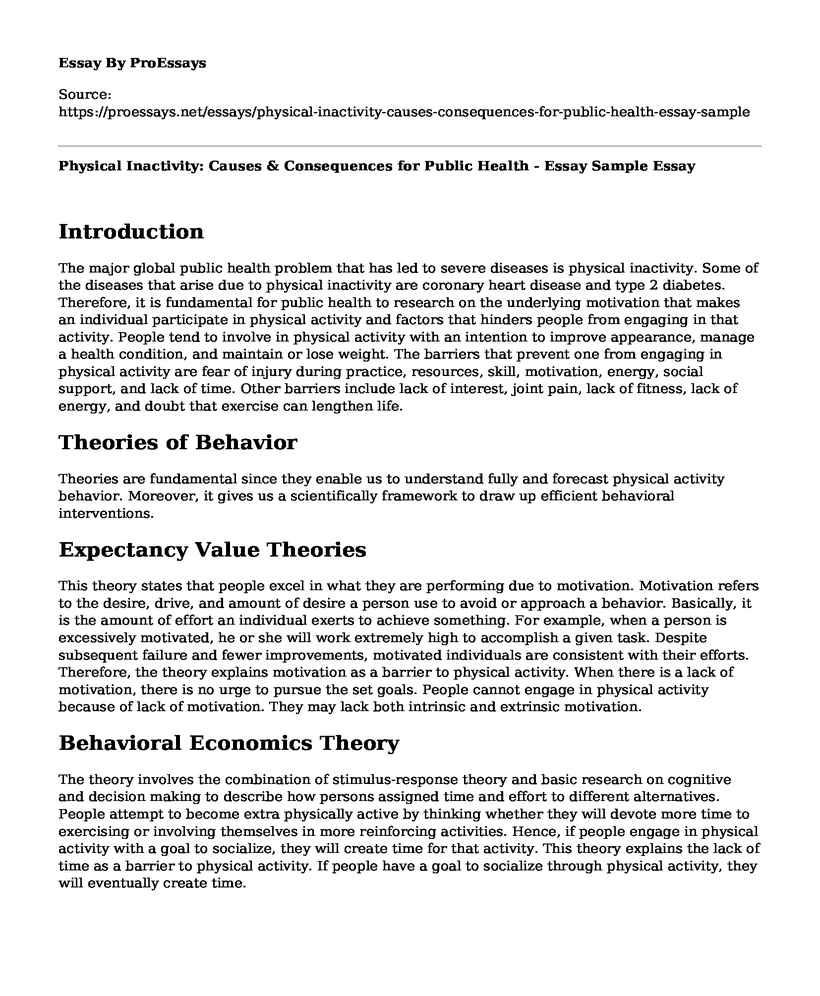Introduction
The major global public health problem that has led to severe diseases is physical inactivity. Some of the diseases that arise due to physical inactivity are coronary heart disease and type 2 diabetes. Therefore, it is fundamental for public health to research on the underlying motivation that makes an individual participate in physical activity and factors that hinders people from engaging in that activity. People tend to involve in physical activity with an intention to improve appearance, manage a health condition, and maintain or lose weight. The barriers that prevent one from engaging in physical activity are fear of injury during practice, resources, skill, motivation, energy, social support, and lack of time. Other barriers include lack of interest, joint pain, lack of fitness, lack of energy, and doubt that exercise can lengthen life.
Theories of Behavior
Theories are fundamental since they enable us to understand fully and forecast physical activity behavior. Moreover, it gives us a scientifically framework to draw up efficient behavioral interventions.
Expectancy Value Theories
This theory states that people excel in what they are performing due to motivation. Motivation refers to the desire, drive, and amount of desire a person use to avoid or approach a behavior. Basically, it is the amount of effort an individual exerts to achieve something. For example, when a person is excessively motivated, he or she will work extremely high to accomplish a given task. Despite subsequent failure and fewer improvements, motivated individuals are consistent with their efforts. Therefore, the theory explains motivation as a barrier to physical activity. When there is a lack of motivation, there is no urge to pursue the set goals. People cannot engage in physical activity because of lack of motivation. They may lack both intrinsic and extrinsic motivation.
Behavioral Economics Theory
The theory involves the combination of stimulus-response theory and basic research on cognitive and decision making to describe how persons assigned time and effort to different alternatives. People attempt to become extra physically active by thinking whether they will devote more time to exercising or involving themselves in more reinforcing activities. Hence, if people engage in physical activity with a goal to socialize, they will create time for that activity. This theory explains the lack of time as a barrier to physical activity. If people have a goal to socialize through physical activity, they will eventually create time.
How to Apply Theories to Overcome Barriers
Behavioral economics can be used to overcome the time barrier to physical activity by giving incentives to people based on the amount of time they dedicate to their physical activity. If a person increases time for physical activity, more money will be given to him or her as a form of incentive. Secondly, people should be made to sign a contract which states that if they do not performs a physical activity for sometimes; they would be made to pay the penalty as a form of punishment. Commitment contract enables a person to be persistent in their exercise. Additionally, nudging, which involves the setting of defaults, can be applied. Nudging pertains precondition measures of action that can be put in place if the decision-maker specifies nothing. Nudge concept works well with people who have tendencies for inactivity. For example, preconditions such as salary deduction can be put in place for individuals who do not exercise.
Expectancy value theories can be used to influence motivation by attaching the value in doing exercise. The value of participating in exercise is what drives people to participate more and fully. People who train people to engage in physical exercises should set achievable targets. Achievable targets motivate a person to engage in more exercise as opposed to none-achievable targets. Expectancy belies to achieve set goals in combination with the provision of sufficient incentives increases motivation to do more exercise. Therefore, it is fundamental to examine incentives like outcome values, task value, and expectancy beliefs and integrated to promote motivation.
Cite this page
Physical Inactivity: Causes & Consequences for Public Health - Essay Sample. (2023, Apr 14). Retrieved from https://proessays.net/essays/physical-inactivity-causes-consequences-for-public-health-essay-sample
If you are the original author of this essay and no longer wish to have it published on the ProEssays website, please click below to request its removal:
- The Priory Hospital: Marketing Analysis
- Essay Example on Health Care Reform Act
- Vegan Diet Essay Example
- Paper Example on Maximizing Performance in Healthcare: Why Project Portfolio Management Matters
- Research Paper on Advanced Practice Nurses: Enhancing Access, Cost, and Quality
- Research Proposal: China Facing a Diabetes Crisis: Prevalence & Health Impact
- Paper Sample on Successful Pancreatic Extract Treatment of Diabetes Mellitus







